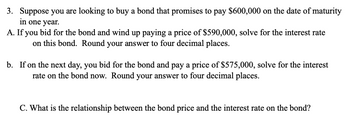
ENGR.ECONOMIC ANALYSIS
14th Edition
ISBN: 9780190931919
Author: NEWNAN
Publisher: Oxford University Press
expand_more
expand_more
format_list_bulleted
Question
thumb_up100%

Transcribed Image Text:3. Suppose you are looking to buy a bond that promises to pay $600,000 on the date of maturity
in one year.
A. If you bid for the bond and wind up paying a price of $590,000, solve for the interest rate
on this bond. Round your answer to four decimal places.
b. If on the next day, you bid for the bond and pay a price of $575,000, solve for the interest
rate on the bond now. Round your answer to four decimal places.
C. What is the relationship between the bond price and the interest rate on the bond?
Expert Solution
This question has been solved!
Explore an expertly crafted, step-by-step solution for a thorough understanding of key concepts.
This is a popular solution
Trending nowThis is a popular solution!
Step by stepSolved in 4 steps with 4 images

Knowledge Booster
Learn more about
Need a deep-dive on the concept behind this application? Look no further. Learn more about this topic, economics and related others by exploring similar questions and additional content below.Similar questions
- Bond A pays $8,000 in 28 years. Bond B pays $8,000 in 14 years. (To keep things simple, assume these are zero-coupon bonds, which means the $8,000 is the only payment the bondholder receives.) Suppose the interest rate is 5 percent. Using the rule of 70, the value of Bond A is approximately Now suppose the interest rate increases to 10 percent. Using the rule of 70, the value of Bond A is now approximately I The value of a bond rate. and the value of Bond B is approximately and the value of Bond B is approximately Comparing each bond's value at 5 percent versus 10 percent, Bond A's value decreases by a when the interest rate increases, and bonds with a longer time to maturity are percentage than Bond B's value. sensitive to changes in the interestarrow_forwardSuppose the current annual interest rate on a one-year government bond is 8% and the expected annual interest rate on a one-year bond one year from now is 8.5%, and a one- year bond two years from now is 9%. Based on this information, the current annual interest rate on a three-year government bond is approximately, A. 8.0% B. 9.0% 8.5% D. 8.2% 10% ABCDE C. E.arrow_forward2. In a two-period model, Jennifer expects to earn income of £15,000 in the second period but nothing in the current period; whereas Martin has income of £15,000 in the current period (everything adjusted for inflation). The real interest rate for both borrowing and lending is 30%. a) What is the present value of Jennifer’s future income? b) Show diagrammatically why Martin is better off than Jennifer. c) Show diagrammatically the impact of a fall in the interest rate for both Martin and Jennifer. Is it possible for a fall in interest rates to make Jennifer better off than Martin? d) Comment briefly on the implication of your answer to part (c) for the effectiveness of monetary policy carried out by changing the central bank interest rate.arrow_forward
- If the price of a government bond (gilt) traded on the stock market rises above its nominal value, which of the following statement must be true? 1 -The bond's coupon falls below the yield 2 - The bond's coupon rises above the yield 3-the bond's yield rises above the coupon 4 - the bond's yield falls below the couponarrow_forwardThe demand D (in billions of £) for a bond with coupon rate 5% and face value FV = 1000, and two years to maturity as a function of its price P is D = 4000 − 2P. The supply in (billions of £)as a function of the price of the bond is S = 2P + 400. b) Suppose that the yield to maturity of the bond is i = 0.05. What is the quantity demanded/supplied at this interest rate? What happens to the demand/supply of the bond as the interest rate increases? Explain why. c) What is the equilibrium interest rate? d) Suppose that the bond trades at premium. Is there excess demand or supply? Explain. e) There is a business cycle contraction, so both supply and demand shifts. After the shift, the new demand curve is given by: D = 4000 + X − 2P , whereas the new supply curve is S = 2P + 200. For which values of X will the interest increase/decrease? Which values of X are in line with empirical data?arrow_forwardWhat determine the Structure of Interest Rates and name the three primary shapes of the Structure of Interest Rates?arrow_forward
arrow_back_ios
arrow_forward_ios
Recommended textbooks for you

 Principles of Economics (12th Edition)EconomicsISBN:9780134078779Author:Karl E. Case, Ray C. Fair, Sharon E. OsterPublisher:PEARSON
Principles of Economics (12th Edition)EconomicsISBN:9780134078779Author:Karl E. Case, Ray C. Fair, Sharon E. OsterPublisher:PEARSON Engineering Economy (17th Edition)EconomicsISBN:9780134870069Author:William G. Sullivan, Elin M. Wicks, C. Patrick KoellingPublisher:PEARSON
Engineering Economy (17th Edition)EconomicsISBN:9780134870069Author:William G. Sullivan, Elin M. Wicks, C. Patrick KoellingPublisher:PEARSON Principles of Economics (MindTap Course List)EconomicsISBN:9781305585126Author:N. Gregory MankiwPublisher:Cengage Learning
Principles of Economics (MindTap Course List)EconomicsISBN:9781305585126Author:N. Gregory MankiwPublisher:Cengage Learning Managerial Economics: A Problem Solving ApproachEconomicsISBN:9781337106665Author:Luke M. Froeb, Brian T. McCann, Michael R. Ward, Mike ShorPublisher:Cengage Learning
Managerial Economics: A Problem Solving ApproachEconomicsISBN:9781337106665Author:Luke M. Froeb, Brian T. McCann, Michael R. Ward, Mike ShorPublisher:Cengage Learning Managerial Economics & Business Strategy (Mcgraw-...EconomicsISBN:9781259290619Author:Michael Baye, Jeff PrincePublisher:McGraw-Hill Education
Managerial Economics & Business Strategy (Mcgraw-...EconomicsISBN:9781259290619Author:Michael Baye, Jeff PrincePublisher:McGraw-Hill Education


Principles of Economics (12th Edition)
Economics
ISBN:9780134078779
Author:Karl E. Case, Ray C. Fair, Sharon E. Oster
Publisher:PEARSON

Engineering Economy (17th Edition)
Economics
ISBN:9780134870069
Author:William G. Sullivan, Elin M. Wicks, C. Patrick Koelling
Publisher:PEARSON

Principles of Economics (MindTap Course List)
Economics
ISBN:9781305585126
Author:N. Gregory Mankiw
Publisher:Cengage Learning

Managerial Economics: A Problem Solving Approach
Economics
ISBN:9781337106665
Author:Luke M. Froeb, Brian T. McCann, Michael R. Ward, Mike Shor
Publisher:Cengage Learning

Managerial Economics & Business Strategy (Mcgraw-...
Economics
ISBN:9781259290619
Author:Michael Baye, Jeff Prince
Publisher:McGraw-Hill Education